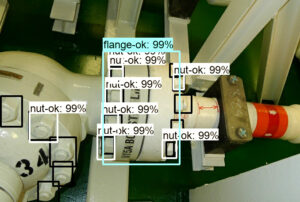How Machine Learning can improve Integrity Management
Quick access to data through image recognition
Axess has developed an inspection software to increase the efficiency of the inspection work process through conventional software solutions. To further improve its functionality, machine learning may be used for object detection on images and video. Machine learning is an artificial intelligence (AI) application that analyses large amounts of data and algorithms, learnt through observation to find patterns, and thereby foresee future issues based on historic data.
An example is during inspection of lifting equipment, machine learning can identify the objects from the images taken by the field technician. Finding the correct equipment type, model, acceptance criteria and applicable compliance rules in an automated fashion reduces the time used on reporting and accessing relevant data.

Condition evaluation
With machine learning paired with inspection software, it is possible to derive condition evaluation from images taken by the inspector. Anomalies in data collected such as corrosion detection, cracks, spillage or leaks can be assessed and captured in real time by these tools for a quick comparison of the asset condition today with the previous inspection period. This subsequently determines the next course of action necessary in the asset management lifecycle. With this type of solution, it is possible to acquire more data and evaluate the technical condition based on quantitative analysis as opposed to the qualitative analysis done by field engineers and inspectors today.
Risk analysis
The knowledge acquired from condition evaluation leads to a thorough assessment of the damage, specifically, the probability of failure and consequence of failure. To improve the understanding and evaluation of risk, it is necessary to build a tool to estimate the probability of failure. Machine learning can be used to prepare models to predict the outcome from the input parameters and correlated historic results.
It is suggested to prepare models for prediction of probability and severity of degradation mechanism based on process information, materials and inspection history. This needs a large data set to produce a reliable and accurate inspection strategy: focusing on components with the highest risk, coverage and frequency of inspections. The result is a more optimised use of inspection budget to reduce the overall risk.
Conclusion
Inspection software, when paired with machine learning, can improve business services significantly—from defects identification to compliance and maintenance solutions. This innovative methodology will increase the rate of data capture, provide comprehensive real-time data comparison, and allow new types of data to be used for condition evaluation. At Axess, we leverage technology to continuously deliver accurate and reliable asset integrity solutions.
Currently, Axess has an ongoing project covering the profitability of machine learning, supported by the Norwegian Regional Research Fund and some academic and industry partners. The results will be presented at the SPE International Oilfield Corrosion Conference and Exhibition in Aberdeen 18-19 June 2018. We hope to see you there!
For future collaboration, contact us at [email protected]